The Colorado Avalanche are advancing to Round 2 of the Stanley Cup Playoffs. However, a number of top seeds are not. For those looking for a team to follow and possibly considering the Avalanche, here’s a handy overview of one of the NHL’s lesser known teams.
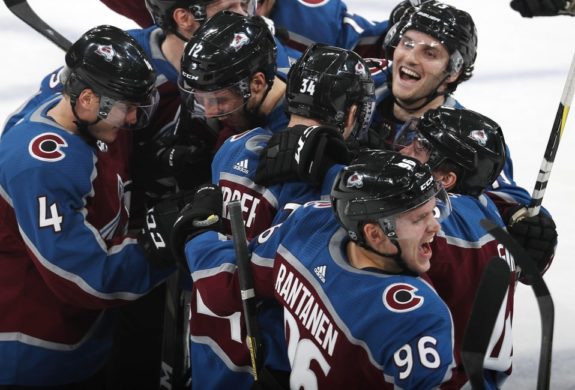
And for the ones who have been faithfully following the team all along, consider this a light-hearted refresher to gear up for the gritty series against the San Jose Sharks.
Avalanche Basics
The Avalanche earned the final wild card spot in the Western Conference. Though they slot into the Central Division, because they were the last wild card team, they are competing in the Pacific Division. Should they defeat the Sharks, they would win the Pacific. That’s the crazy world of Gary Bettman’s NHL. Don’t ask me.
The Avalanche have been in the news the past couple of years for two things – their notoriously awful 48-point season in 2016-17 and Nathan MacKinnon. There IS actually an entire team of players suiting up for Colorado, but most people outside the region would have no idea who any of them are. More on MacKinnon later.
The head coach is Jared Bednar. The Avalanche’s general manager Joe Sakic (former NHL star) hired him shortly after previous head coach Patrick Roy quit (yes, that Roy, the legendary All-Star goaltender). Bednar had never coached or played in the NHL but he had worked his way up the coaching ranks of the Columbus Blue Jackets organization, helping them to win both an ECHL and AHL championship.
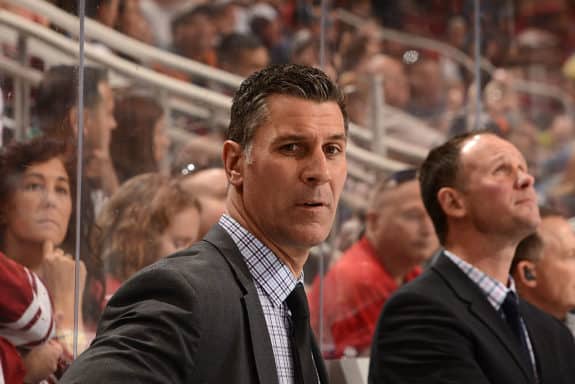
Bednar joined the Avalanche just a couple of weeks before the rookies reported for training camp for the aforementioned never to be discussed again 48-point season. He focused on playing by merit and stressed the value of teamwork.
The coach is noted for his equilibrium, to the point sometimes people wonder if he has a pulse. Outrageous calls go against the team? Bednar maintains a grim even keel. Coaches’ challenge denied? He gives a little head tilt and keeps his somber expression. A series of questionable calls? He may calmly ask to speak to a referee, where they have a reasonable discussion. The Avalanche score? Maybe a quick half smile and back to work. Bednar provides the perfect even keel to a young Avalanche team focused on the task at hand – winning games.
Meet the Real Avalanche Forwards
The Avalanche actually have four good lines of hockey players, not just a couple of stars. Who knew, right? Let’s break down the forward line combinations by how the Avalanche have run them out at the start of games.
The Top Line – Landeskog-MacKinnon-Kerfoot
Most people have heard about MacKinnon, their scoring star. Yes, he was a 99-point player this season and racked up eight points in five playoff games to date. Yes, he led the league in shots on goal. But MacKinnon does more than put pucks in nets. He is a playmaker, using his size and speed to push into the offensive zone and create havoc. He centers the team’s top line.
The team captain – Gabriel Landeskog – plays on the left wing. Landeskog frequently takes the face-offs for the top line, does the dirty work to get pucks out of the corner and battles for space in front of opposing goaltenders.

Landeskog is an artist when it comes to puck deflection and knows when to screen opposing goaltenders as well as when to hop out of the way of the puck. Landeskog may not get as much attention as some of his teammates but he is definitely the engine that keeps the group moving forward.
Now onto the surprise. Despite what many may have heard, Mikko Rantanen has NOT been playing right wing on the top line recently. That honor goes to Alexander Kerfoot. Haven’t heard of him? Many haven’t. He’s in his second year with the team and took over on the right wing when Rantanen was injured in March. Kerfoot is quick and smart. He can keep up with MacKinnon and set up plays with Landeskog. He accumulated 42 points over the course of the season, one of the bigger contributions for a guy most haven’t heard of.
Wilson-Soderberg-Rantanen
Rantanen is the biggest name on this line. He had an 87-point season and leads the team with nine posts so far in the postseason. He is a big (6-foot-4), fast, young (22-years-old) and highly skilled player.

Rantanen has recently started using his size more to fight for pucks, is great at guarding the puck once he has it and has a tendency to fall down. Yes, you read that right. Sometimes he looks like a baby giraffe trying to get his legs. Mikko spent a lot of time playing on the top line with Landeskog and MacKinnon in the regular season. He still joins them on the first power play unit and on occasion when Bednar sees the need.
Carl Soderberg, on the other hand, hasn’t received anywhere near the attention of the big stars but his contributions have been substantial. He racked up 49 points in the regular season, the highest for any forward outside of the MacKinnon, Rantanen, Landeskog trio. Partially blind in one eye, Soderberg eats the tough minutes, frequently facing off against opponent’s top lines. He racks up a huge amount of time on the penalty kill and he’s not afraid to check a guy.
Left wing Colin Wilson has added a dynamic spark to the Avalanche this season. He has become a force to be reckoned with in the playoffs as he ranks fourth on the team in postseason points, tied with Landeskog and Matt Nieto. He adds another level of physicality to the Avalanche as he’s willing to throw himself on the ice for a potential deflection or take a hit to win the puck.
Overall, this line is one of the more underrated combinations, bringing a bruising presence paired with a skilled game who can also shut foes’ down.
Nieto-Compher-Calvert
This combination could easily be called the Mighty Mouse line. J.T. Compher is the tallest member at an even 6-foot but the other two are listed at 5-foot-11. This group has a surprising amount of speed for a third line. They all also exhibit the expected grit quotient. Unsurprisingly, all three log a bunch of minutes on the penalty kill.
Compher centers the line and has a knack for scoring crucial goals when the team needs a boost. In fact, the fanbase has created a meme based on a local ad – who are you going to call when the Avalanche need to score? J.T. Compher – 877-GOLZ-NOW.
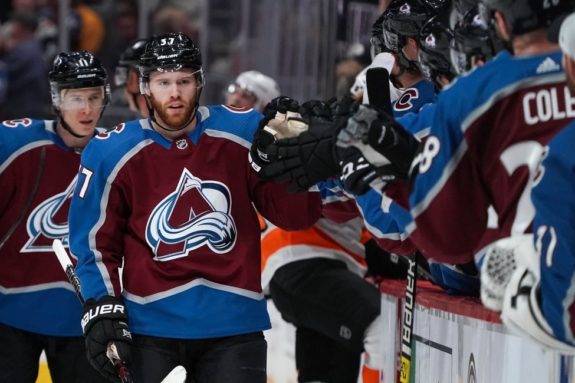
He tallied 32 points in the regular season, right behind Kerfoot, and plays tough minutes on the penalty kill. He’s scored two important goals in the playoffs. If the team needs to get going, look to Compher to see what he’s up to. He’s a game-changer.
Left wing Matt Nieto hails from, wait for it, Long Beach, California. Wanna’ irritate an Avalanche fan? Mention that little factoid. It seems to be the only thing some media members know about him. Nieto is a playmaker. He has already scored two short-handed goals in these playoffs, leading the league. Nieto has willingness to sacrifice his body to stop a puck and is one of Bednar’s trusted players in difficult circumstances. He is one of the staples on the penalty kill. And he has an irresistible smile.
Some may know Matt Calvert from the Columbus Blue Jackets. Acquired during the offseason, Calvert probably has the highest grit-per-60 quotient on the team. He plays every minute on the ice full out and has earned the respect of the fanbase by willingly throwing down with any player, regardless of how outmatched he may be. Calvert earned a badge of honor by taking a puck to the family jewels in the waning moments of the game that sent the Avalanche to the playoffs.
Andrighetto-Jost-Bourque-Brassard
Yeah, this line has four people on it. Why? Because Bednar will shuffle both the third and fourth line based on the team’s they are facing, who’s healthier and whatever else coaches consider.
Center Tyson Jost is a 21-year-old first round pick who is a solid puck mover and can be dangerous in front of the net. He can play well on just about any of the Avalanche lines but the injuries to other centers has relegated him to fourth line status.

Jost may be one of the players shuffled up if Bednar sees a fit he likes. This line actually matched up well against Calgary’s fourth line and drove a lot of pressure on their goaltender Mike Smith.
Sven Andrighetto is the speedster on right wing. He also can play up a line or two but his versatility on the back end has been needed. His skillset is such that he can be used in a lot of different situations, but he’s had a tough year. While he’s likely to break out and rush the net, he hasn’t had his usual scoring luck.
Gabriel Bourque is the little engine that could on this line. Considered a borderline NHL player by some, he’s managed to earn the respect of the coach with his solid play on the penalty kill and his responsible positioning. He isn’t fancy. He isn’t flashy. But he’s solid.
Derick Brassard was added at the trade deadline and while he showed glimpses of his playoff prowess early in the series against the Flames, he became ill and missed the last three games. Healthy, he can slot in anywhere from the second line to the fourth. He brings a more physical presence to the fourth line.
Bednar’s Blender
It’s time to cover one of the more interesting aspects of the Avalanche. Coach Bednar rolls out line combinations and player pairings and then does something fairly consistently – he puts them in the Bednar Blender. He mixes them all up. In Game 5 against the Calgary Flames, at one point MacKinnon was on the ice with fourth line forwards Bourque and Andrighetto.
Whether it’s his way of getting the team to stay sharp or because he sees matchups he likes, one can expect to see a fair amount of line shuffling on the Avalanche during the course of a game. And the blender isn’t limited to forwards. He also mixes up defensive pairings, sometimes putting scoring pairs out together or even three defensemen.
At one point in March, as injuries created havoc, Bednar rolled out 11 forwards and seven defensemen for a few games. The Avalanche found a way to make it work and earned a few key wins to help keep them in the postseason hunt.
The Bednar blender does have it drawbacks, though. Occasionally, the team will get confused about who is up next and earns a penalty for too many men on the ice. So if you see different combinations of players in the middle of the game, no, you are not crazy. It’s just the blender mixing things up.
The Avalanche Defensemen
Colorado finds itself in a new situation. They may actually have too many good players on the blueline causing conundrums for the coaching staff. It’s a whole new world for the Avalanche who had to call up three AHL players to help on the blueline against the Nashville Predators in last year’s playoff series.
Injuries have shuffled things a bit so the pairings are all subject to change. Particularly with the team’s most recent addition.
Introducing Cale Makar
Let’s introduce the Avalanche’s new toy and the reason for the defensive pairings being in flux – Cale Makar. The 20-year-old was Colorado’s first round draft pick after the disastrous season that shall not be named. He spent two years playing for UMass, which started out rebuilding their hockey team and ended up playing for the NCAA national championship April 13.
Along the way, Makar led UMass to its first ever Frozen Four appearance, winning their semifinal game, and being recognized as the Hobey Baker winner.

The Sunday after losing in the championship game, Makar signed his entry level contract and flew to Denver where he played in the Monday night playoff game against his hometown heroes – the Flames.
In his first ever NHL game, a playoff matchup no less, Makar scored his first ever NHL goal, the game winner against Calgary. In the next two games against Calgary, he logged over 20 minutes of ice time and added an assist to his resume. He also played on the power play. Welcome to the big leagues!
But Makar doesn’t just score. He moves the puck through the neutral zone with precision, has great on ice awareness and plays a solid defensive game, able to both steal the puck and guard the net.
Makar stepped in for injured defenseman Samuel Girard. Now the challenge for the Avalanche, Girard just started practicing in a regular jersey. Who to play?
Johnson-Cole
Veteran Avalanche defenseman Erik Johnson started playing with Ian Cole during the Flames series after Girard went down. During the regular season, Johnson and Girard were the usual top pairing.
Johnson is the Avalanche’s top shut down defenseman. While he didn’t get a lot of flashy points during the Flames series, he effectively shut down their star scorer Johnny Gaudreau, limiting him to a single assist during the series.

He usually plays in the shutdown role but he can also score, as he earned two points in the series. In his ninth season with the team, Johnson is a fan favorite and a big ambassador for the Avalanche.
Cole brings a physical toughness to his role as a shutdown defenseman. Acquired in the offseason, he brings playoff experience to the team and skates the line between physical play and borderline penalty. He isn’t a cheap shot artist but he will battle for position against anybody and doesn’t mind throwing his weight around. He played most of the regular season with Tyson Barrie, acting as the defensive anchor to Barrie’s skilled scoring pressure. He also led the team in penalty minutes and blocked shots.
Both Johnson and Cole play substantial roles on the penalty kill. The grit factor on both of them is off the charts.
Zadorov-Barrie
This pairing will cause you to scream in excitement or terror, frequently within moments of each other.
Nikita Zadorov is a beast at 6-foot-five and over 220 pounds. The big Russian has a flare for the dramatic and has developed the skill of making the right hit at the crucial moment. Against the Flames, he ended up sitting on Matthew Tkachuk after he nearly took out MacKinnon. Tkachuk kept playing but he stopped trying to kill Avalanche players. There’s a reason he led the team in hits over the course of the regular season.

Zadorov occasionally has a ‘what are you doing moment?’ but the rest of his play makes up for it. He finished the season with the best plus/minus on the blueline at plus-20. During the regular season, he spent most of his time paired with Patrik Nemeth. Zadorov’s essentially a giant with a big heart. Unless you’re on the opposing team. Then be afraid. Very afraid.
In case you missed it, and many have, Tyson Barrie has had a dominating spring. Known for his penchant for scoring, his defense has been suspect for years. But this spring? He’s discovered his checking game. He’s also been a scoring machine, racking up 59 points in regular season and contributing five assists in the postseason so far. Barrie quarterbacks the first power play unit and gets a fair number of goals there. He still has his share of “what?!” moments. It’s one of the reasons he was paired with Cole for much of the regular season. There’s usually one gut check moment in every game. Just prepare for it and relish his play the rest of the time.
Nemeth-Makar?
Nemeth is the third-pairing stalwart on the blueline. He isn’t flashy. He’s solid. He’s responsible. He’s one of the goaltender’s most dependable defensemen. Nemeth logs a bunch of time on the penalty kill. Passing and shooting are not his strong suit.

But he is tenacious in his own end and very aware how to best help his goaltender. Every team needs a guy like this. Steady. Stable. During the regular season he spent a good portion of his time paired with Zadorov and is likely to again in the upcoming series. If anyone questions Nemeth’s value, remind them that David Warsofsky played on the third pairing last postseason. That should shut them up.
After Girard was injured and Makar stepped in, Makar played most of his minutes with Nemeth. But since he’s already been discussed, it’s time to move on.
Samuel Girard
Girard has been the Avalanche’s own whirling tornado. One of his favorite moves is to spin away from players trying to check him. He has a remarkable transition game, is great at getting the puck through the neutral zone and feeding the offense.

The 20-year-old is only 5-foot-10, which is probably the only concern about his game. Girard has no problem challenging players for the puck, regardless of size, and his stick work is impressive enough he frequently comes away with the puck. His game has continued to improve ever since he came over in the Matt Duchene trade. Girard quarterbacks the second power play unit and usually plays on the top pairing with Johnson.
Defensive Depth
The Avalanche have the luxury of having two highly competent blueliners currently riding the pine. Mark Barberio who is a veteran with 251 NHL games under his belt has battled injuries most of the season and is currently a healthy scratch. The other is Ryan Graves, a rookie who earned a spot on the roster when filling in for injured players. Both players are not likely to ice time in the postseason unless there is an injury, especially since Makar came on the scene and Girard looks to return to the lineup.
The Avalanche depth at defense has gone from night to day in two years. It’s a fun challenge to have even if it’s a bit confusing. Again, who knows what will happen with the blender but an embarrassment of riches on the blueline can only bring good things in the postseason.
Dynamic Goaltending
Philipp Grubauer stepped up in a humongous way down the stretch, helping the Avalanche make it to the postseason. His performance in the playoffs was overshadowed by the Flames’ Mike Smith. But his .939 save percent (SV%) puts him third for postseason play and his 1.90 goals against average (GAA) places him second.
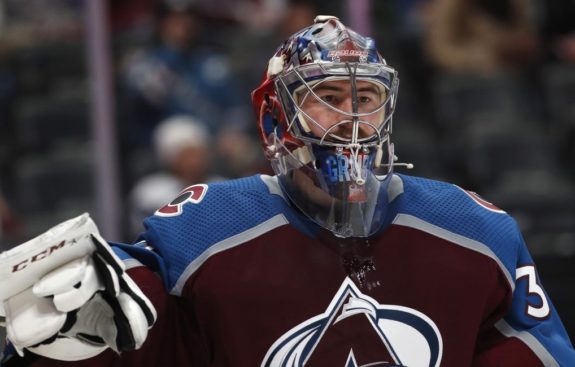
Grubauer has made some spectacular saves to keep the Avalanche in games. It is a huge turnaround from a disastrous December and January where his SV% hovered around .850, well below league average. He wasn’t alone. Semyon Varlamov struggled similarly over the same period. Whether the new goaltending equipment threw them off or something else, both recovered their form towards the end of the season.
Don’t expect to see Varlamov in net, though. Grubauer has earned the starting spot. His smooth glove work and swift leg saves are things of beauty. He may not be as dramatic as some netminders but his work speaks for itself.
Final Words
If you are new to the Avalanche, welcome aboard! You will find a passionate, though frequently overlooked fanbase, and a young and exciting team with a bright future. All newcomers are welcome!
A couple of parting words. Avalanche games are not for the weak of heart. They are a fast team and the action can shift on a dime. The team may look lethargic only to suddenly turn on the after burners where they open up a slot for a breakaway, creating a flurry of shots on goal.
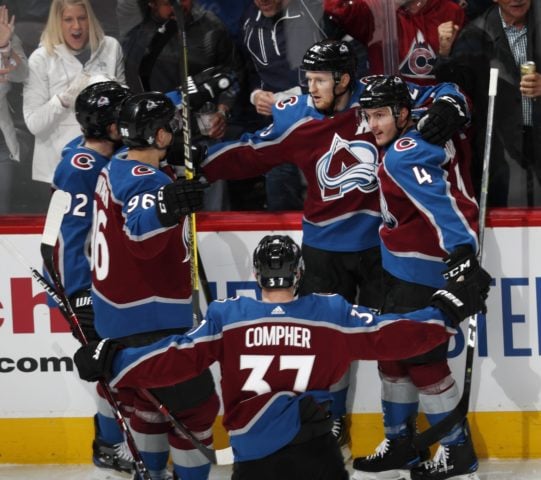
They are a dynamic team and they are young. Prepare for feeling both stressed and exhilarated, frequently at the same time. Have comfort food, drinks and whatever else handy. And remember, despite a couple of big names, this Avalanche group is a team.
Welcome to the roller coaster ride that is the Colorado Avalanche. Please put on your seat belts as it’s likely to have a fair number of twists and turns with rarely a dull moment!